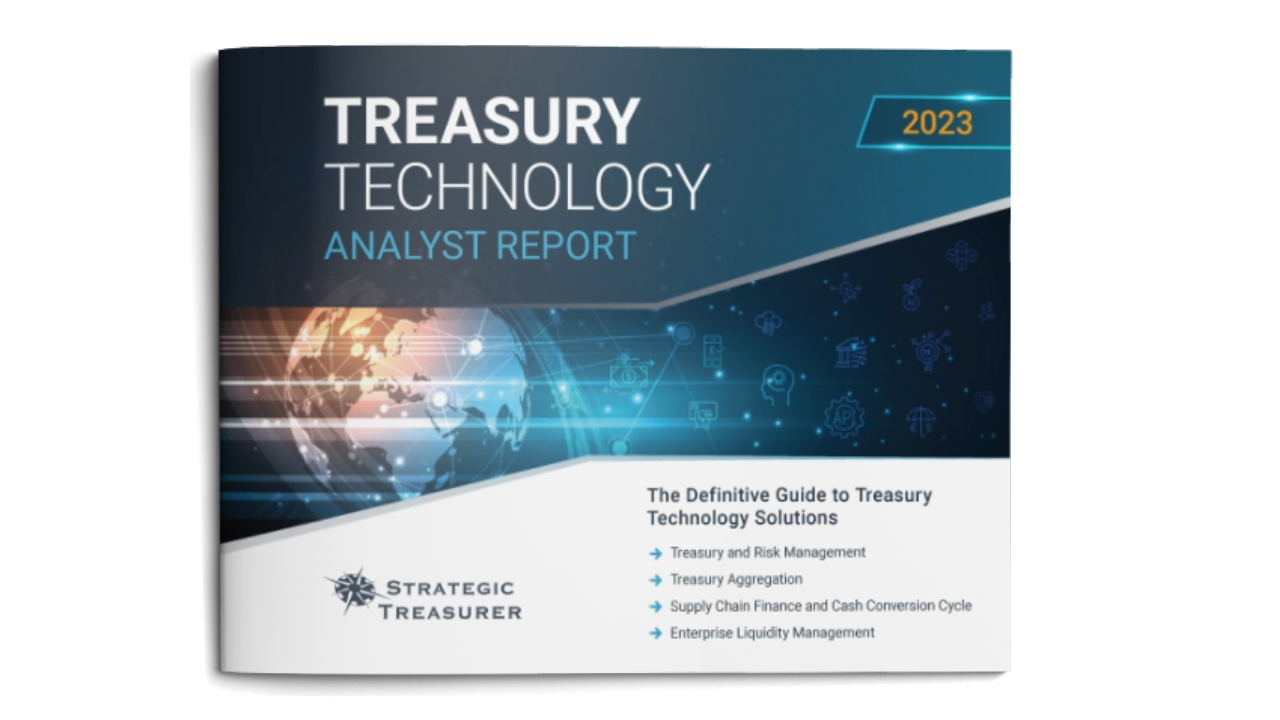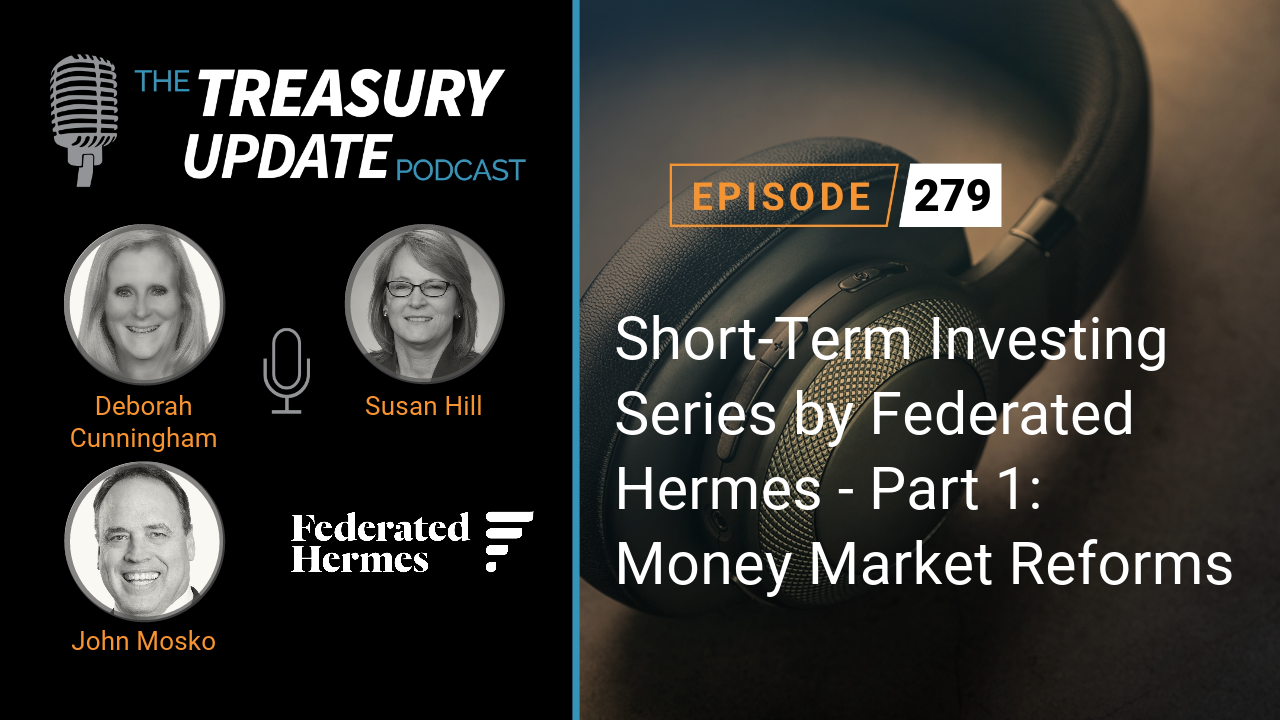
Episode 289
Short-Term Investing Series by Federated Hermes – Part 2: Cash and Credit Considerations
Join us for another installment of the Short-Term Investing Series by Federated Hermes on the Treasury Update Podcast. In this episode, experts from Federated Hermes discuss the nuances of short-term investments, focusing specifically on cash and credit considerations. The conversation touches on credit quality, duration, economic outlook, yield curve, money market funds, managing asset-backed securities, and more.
Speakers:
- Craig Jeffery, Managing Partner at Strategic Treasurer
- Mark Weiss, CFA, Vice President, Senior Portfolio Manager, Federated Investment Management Company
- Nicholas Tripodes, CFA, Senior Vice President, Senior Portfolio Manager, Head of Low Duration/Structured Products Group, Federated Investment Management Company
- John Mosko, Senior Vice President, Liquidity Management Division, Federated Securities Corp.
Visit federatedhermes.com for more information.
Show notes:
To learn more about the topics discussed, please refer to the following links:
Views are as of December 13, 2023, and are subject to change based on market conditions and other factors. These views should not be construed as a recommendation for any specific security or sector. You could lose value by investing in a money market fund. Although some money market funds seek to preserve the value of your investment, at $1.00 per share, they cannot guarantee they will do so. An investment in money market funds is not a bank account and is not insured or guaranteed by the Federal Deposit Insurance Corporation or any other government agency. Past performance is no guarantee of future results. Federated Securities Corp is a distributor of the Federated Hermes Funds and is not affiliated with Strategic Treasurer. Bond prices are sensitive to changes in interest rates and a rise in interest rates can cause a decline in their prices. Short duration bond funds are not “money market” mutual funds. Some money market mutual funds attempt to maintain a stable net asset value through compliance with relevant Securities and Exchange Commission (SEC) rules. Short duration funds are not governed by those rules, and their shares will fluctuate in value. The value of some asset-backed securities may be particularly sensitive to changes in prevailing interest rates, and although certain securities may be supported by some form of government or private guarantee and/or insurance, there is no assurance that private guarantors or insurers will meet their obligations. Credit ratings do not protect against market risk.
Speaker:
Mark Weiss, Federated Hermes


Speaker:
Nicholas Tripodes, Federated Hermes


Co-Host:
John Mosko, Federated Hermes


Co-Host:
Craig Jeffery, Strategic Treasurer


Subscribe to the Treasury Update Podcast on your favorite app!
Episode Transcription - Episode # 289: Short-Term Investing Series by Federated Hermes - Part 2: Cash and Credit Considerations
Announcer 00:04
Welcome to the Treasury Update Podcast presented by Strategic Treasurer, your source for interesting treasury news, analysis, and insights in your car, at the gym or wherever you decide to tune in.
Craig Jeffery 00:18
Welcome to the short term investing series by Federated Hermes on the Treasury Update Podcast. This is brought to you by Federated Hermes and more information about Federated can be found at federatedhermes.com/us. Today’s episode is called Cash and Credit Considerations. Listen in as Federated Hermes and Strategic Treasurer discuss the implications of the current economic outlook in the context of historical interest rate trends, and how this impacts investor considerations. The conversation examines differences in credit quality and the duration in this environment and expectations about moving out on the yield curve including some shorter duration asset backed securities. Our co-host for today’s podcast is John Mosko from Federated Hermes and we are joined by two guest speakers. From the Federated Hermes liquidity investment team we have Mark Weiss, CFA, Vice President, Senior Portfolio Manager. He is responsible for portfolio management and research in the fixed income area and he concentrates on liquidity portfolios. Welcome to the podcast, Mark.
Mark Weiss 01:18
Thanks for having me.
Craig Jeffery 01:20
And from the Federated Hermes fixed income investment team, we have Nicholas Tripodes, CFA, Senior Vice President, Senior Portfolio Manager. He is the head of their low duration structured products group. He is responsible for portfolio management and administration of low duration multisector products with concentrations in investment grade securities, as well as management administration of structured product allocations within the federated Hermes fixed income complex. Welcome to the show, Nick.
Nicholas Tripodes 01:46
Thank you, Craig.
Craig Jeffery 01:47
Mark and Nick are co-chairs of Federated Hermes short-term investments committee. This is a collection of in-house investment professionals with in-depth experience investing across the zero to three year part of the yield curve. They meet monthly to provide insights, strategize and discuss investment opportunities. In the shownotes, you’ll find links to various reports discussed in this podcast, as well as the link to federatedhermes.com/us. John, why don’t you start us off?
John Mosko 02:13
Thanks, Craig. And hello, Nick, Mark. Thanks for joining us today. I think this is so timely as we start 2024 There’s so much chatter and there’s been chatter around what’s going to happen to the Fed this year? And to think about what corporate how corporate treasurers and practitioners think about their cash extension. What are they going to do with siloing their cash? How do they feel about credit? So, you know, I think this is a really super time to have conversations about how to think about this. So we think about, historically speaking, and it’s kind of a tricky slope to go down, because you kind of strip out and you kind of want to strip out the period of time between so the financial crisis in 2016, we went through almost seven years of 0% Fed funds rate. And it’s only been in the last six or seven years minus again, COVID-19, where we started to become acting more normal in terms of short term interest rates and where rates are on things like the 10 year treasury. So from a contextual perspective, it’s important to think about that. Now granted, a lot of folks think about their cash, just, I have to pay bills, and I farm out the rest. And this is the perfect time to talk about that. So why don’t we start, Mark, with kind of talk about how you all in the front end of the curve, think about the Fed. We had the December Fed meeting. I don’t think that Fed chairman’s declaring victory just yet. But, you know, from from the liquidity side of the house, what’s the thinking about Fed funds rate and what investors should be considering the rate environment.
Mark Weiss 03:55
Well, let’s take a step back and look at rates where they’ve come. March 2020, we had the COVID pandemic hits the United States, the Fed cuts the Fed funds rate to zero. Meanwhile, inflation marches higher and proves to be sticky. So in March 2022, with core CPI at 6.5%. The Fed begins its battle against inflation and raises the Fed funds rate by 525 basis points over the next 15 months. That’s the most aggressive pace of Fed tightening in the last 30 years, and the Fed funds rate is currently at the highest it’s been since 2001. And over that 30 year time period, we had six tightening cycles. After each of those the Fed began lowering rates and average of nine months after it stopped tightening. And since the Fed began hiking this time, inflation has made progress and GDP is now expected to show below trend growth. The consensus estimates are saying 2.4% for full year 2023 With about 1.2% expected for 2024 with some of those quarters being sub one percent. So not a recession, per se, but slower growth than what we have today. So our last fed hike was in July, which was five months ago. So we’re in that zone where the Fed begins to consider easing. Our last meeting projection from the short term investments committee, which is a group of portfolio managers in the liquidity and moderation space that Nick and I co chair, is for the Fed to cut three times by year on 2024.
John Mosko 05:25
So Nick, if I could bounce it over to you, Mark, and you may think about the same things. But clearly, he’s mostly concerned about a 60 day wham with a 40 act money market fund, you however, have to think more from a bond, you know, duration is a little trickier with for you, the breakevens may be a little easier once you talk about how you’re thinking about the yield curve and where to place purchases as you think about your bond portfolios.
Nicholas Tripodes 05:53
Thanks, John. Historically, in a normal yield curve environment, you can pick up higher yields by taking on additional interest rate risk, we’re in a somewhat unusual yield curve environment where we’re inverted. And the front of the curve or short term rates are longer than medium term rates I’m looking at compared to like a two year treasury. But historically, you know, over the past 20 years or so, investor usually can pick up additional returns by extending duration from a liquidity portfolio to a longer term portfolio. And we think now is a good time for an investor to consider extending duration. As Mark mentioned, you know, we think the Fed is, is done moving, you know, increasing rates right now. So we think, you know, the next movement in the Fed funds rate will probably take place next year. At that time, you know, we think it’s prudent to be longer than a neutral positioning. If an investor does have cash, for instance, to invest in six months or one year or two year, we think it’s appropriate to look at that time horizon, that investor has and invest it in an appropriate duration portfolio that meets that time horizon. So if you if you have immediate cash needs, it’s smart to you know, keep that in very conservative portfolios. But if there’s money that you don’t need for six months, or one year or two years to think about extending that and putting that in longer term portfolios that meet your time horizon, to take advantage of what we expect to see as a more normal interest rate environment over the next year or two.
Craig Jeffery 07:38
So Nick, just diving into that a little bit more, it certainly seems clear there, there’s a record amount of assets and money market funds. And yet there’s quite a bit of talk of duration. And you talked about extending duration, why in this type of environment, if it appears, the economy’s not not roaring, it’s fairly slow, or might be slowing down. Why should that be the case, to look at a pushing out duration?
Nicholas Tripodes 08:00
Well, as you mentioned, and we do see a record amount of assets and money market funds across the industry, I think close to 6 trillion. And that’s really due to, you know, short term rates being so high with the Fed increasing rates recently, and asset flows in general have gone from short duration funds over to liquidity funds. But as the you know, the Fed we think the Fed is done moving, as Mark talked about the short term investment committee 10 out of 10 of the voting members think the Fed is done moving and we’re going to see three to four increases or decreases next year. So now I think is an appropriate time for an investor to think about extending moving from a liquidity fund to a longer term product, because to be in a liquidity product, and to get those returns that we’re seeing now, you really have to be in that asset class for an entire year. But if the Fed does start to lower rates beginning next year, whether it’s q1, q2 or q3, you’ll see rates start to decline, and longer term assets will actually increase in value if rates go down. So we think, you know, duration extension trade is appropriate considering the environment we expect to be in over the next year or so.
Craig Jeffery 09:17
I mean, if if there’s so much money on the short end of the spectrum, and it’s an expectation is that the Fed is not going to be raising, but likely to be lowering what other economic thoughts or considerations should we be having when we think about some of the credit products, you know, moving down the duration, extending duration here?
Mark Weiss 09:37
Sure. So as I mentioned before, consensus for GDP is expected to be 2.4% for 2023. And that’s expected to fall to 1.2% in 2024. So below trend growth, but not a full grown recession. And so in the prime liquidity portfolios, and one of our largest exposures into the financial sector and primarily banks, and we buy CP we buy CDs, we use repo counterparties. So it’s a very important sector to the liquidity space. So we have three analysts that are dedicated on the liquidity team that cover, you know, all of our global banks, includes the US and Canada and Europe and, and others. So let’s talk a little bit about the US. You know, we mostly have the 25 largest banks on our list. Those are the ones that issue the types of paper we’re looking for, and the quantities that we’re looking for, and they’re very strong credits. You know, if we get into a slowdown, asset quality becomes a primary concern. So you have, you know, unemployment rises, corporate profitability declines, that leads to financial stress on borrowers. And that leads to higher loan losses for banks. We know we’re seeing some as a quantity duration, increase in delinquencies and charge offs. But for the most part, it’s coming off of historic lows. So you know, what do you want to see from banks to address potential asset quality issues as you head into a slowing economic period like this? You want to see banks tightening lending standards, and US banks have been doing that since July 2022. You want to see banks building reserves for loan losses that began during the pandemic, and the losses that banks were expecting didn’t really materialize. So they started to release some of those. But now in the past year, they’ve been building them up again, in anticipation for the upcoming slowdown.
John Mosko 11:25
Back in the financial crisis, it was homeownership, right? People got off sides on their mortgage, they had ninja loans. Today, people have mortgages with three handles and two handles, and there’s no way they’re going to sell their house. So they’ll take less money to not have to sell their house to buy a new house because they have to get a 7% mortgage. That said, work from home has created this environment with commercial real estate, right? So office buildings are now half full. People were working three days a week, maybe four. Corporations have to rethink their commercial real estate strategy. The question we’ve talked about you and I and we and clients are asking us is what are the potential effects, if you will, from potentially corporations walking away from leases walking away from buildings? What kind of stress does that is that going to put on those banks that those three analysts cover for us? You know, can you guys, you guys kind of game that out? What does that look like?
Mark Weiss 12:26
Well, you know, what we can do is we can look at the exposures that the banks have to that sector, you had mentioned back during the great financial crisis. And back then, not only was it homeownership, but it was also commercial real estate that presented problems as well. And, but the thing, and you know, since then, banks have de risked their loan books. So they’ve gotten rid of reduced total CRE as a whole. And they’ve even you know, especially focused on those types of CRE that are more problematic than others, for example, you have CRE that is for apartment buildings, right, which tend to do very well and perform very well. You have owner occupied buildings, which tend to do very well. It’s the non owner occupied buildings that tend to do more poorly, because those are your strip malls, those are spaces that you’re, you’re leasing out to someone else. And that would include office space. So those are more concerning parts of CRE. And so as we look at the just using the top 25, banks, the average CRE position as a percentage of loans is about 13%. Now, that’s about probably half of what it was back in, in the great financial crisis. It was probably was between 20 and 30%, back then, or 25%, I would say back in the crisis, and so smaller exposure to CRE. And then if you even delve down into the office space, that office space average for those top 20 Banks is less than 5%. So it’s a very small portion of the loan book. So it should be something that the bank should be able to handle. And it shouldn’t be, it should not be a problem that happens all at once, as if, like you say, companies are going to walk away from their leases. I mean, you’re locked into a lease for, you know, sometimes as long as 10 years. It’s something that, you know, as these leases expire, as companies, you know, negotiate for smaller office space, or maybe fewer floors in a building, or you know, even decide to leave their their downtown space and take it to the suburbs or, or work from home. Those issues will come up. We think it’s something that will happen over time. And it’s something that should be manageable for the banks.
John Mosko 14:34
So if I’m a corporate treasurer, and I’m thinking about XYZ bank, and my boss says that, don’t they have commercial real estate loans or strip malls? Should I be terribly worried? Is the short answer, not really? I mean, obviously, it’s bank, the bank case the case, but historically speaking, not in bad shape.
Mark Weiss 14:54
I would have to say that it depends on the bank, because certainly there are banks that have more exposure to lousy credits. But our team looks at this stuff every day, we look at quantitative information, qualitative information, you know, we’re ripping these banks apart, and trying to determine what risks they do have, and then even stress testing those to see what happens if, you know if losses double or something like that in a certain timeframe. So the credit component is extremely important to this. I mean, you can, you can certainly go out there and find banks that, you know, are going to have more problems than others. But, you know, we’re comfortable with the banks that are on our approved list, because we’ve been doing this for a very long time.
John Mosko 15:36
That helps.
Craig Jeffery 15:37
Well, Mark, Mark, thanks for that, Nick. You know, as we heard some of the discussion, you know, about defaults or you know, a little bit of a tightening in the, in the credit markets, what are your thoughts on this slowdown, the impact of defaults as we look at some of these credit products.
Nicholas Tripodes 15:52
Sure, if you look at corporate credit quality, it’s still relatively strong, even in a softening, inflationary environment and overall economic environment. Management, still conservatively managing the balance sheets in the corporate space, we still expect 2024 earnings per share, to be positive low double digits next year. As a firm, we’re opportunistic with our corporate credit purchases, spreads are still relatively tight compared to treasuries, so we don’t want to overpay for corporate bonds. I would say we approve 3 out of every 10 names to come to market, looking at both fundamental and relative value, compared to not only other corporates, but also other fixed income sectors such as mortgages, and asset backed securities. So we’re still cognizant of the fact that the economy could be slowing, you know, we’re not seeing a lot of signs right now. But we do expect a little bit of slowdown next year. So you know, only approving 3 and a 10 names kind of gives us those higher quality names, where we’re still seeing good fundamental value, good relative value. And, you know, with our stringent credit process and investment grade corporates, purchasing names that we really like companies where we’ve met with the management, we’ve been following them for years, and we understand the credits. So that’s kind of how we’re looking at it from from a credit standpoint.
Craig Jeffery 17:24
That sounds that sounds good. Being a little bit pickier, judicious. John, I know, one of the things we wanted to highlight this time was talking about asset backed securities. Why don’t you take us through that?
John Mosko 17:36
Thanks, Craig. I think when investors think about again, we’ll go back to like reading headlines and having the answer to treasury committees or CFO, you know, I think historically, Federated Hermes does use a lot of asset backed securities, for our liquidity sleeves all across the the front end of the yield curve. So if we could take a moment, Mark, I’m going to start with you, when you think about the asset backed commercial paper you’re buying today, as well as maybe even tranches of asset backed securities. And then Nick, we’re going to work our way out the curve and talk about your world next. So for a second there, Mark, talk to us about the ABCP you’re looking at. And you know, what it looks like.
Mark Weiss 18:18
The ABCP programs that we have on our list are a combination of two different kinds. Some of them are have full liquidity support. So they’ve got credit enhancement from banks where a bank would step in, and, and it’d be no losses to us, because it’s basically has a liquidity agreement with that bank. And then we also have structures that don’t have that type of arrangement. And for that, we’re counting more so on the structure and the protection around those individual pools. Some of the things we look at when we evaluate those structures are, you know, we want a good sponsor history, we want someone that we know has been in the business for a while, as a good servicing experience on how they manage their pools. We want to make sure that the types of receivables that are in those pools are receivables that we are comfortable with, we want to make sure that the pools are very granular in nature, so that you don’t have one large loan that goes bad and it impacts the whole pool negatively. We want to, you know, take a look at the loss history. And you know, has that has that sponsor, you know successfully managed through difficult times and what has their loss history been on the pools that they’ve run? We also look for other credit enhancement like over collateralization. I’m sure Nick will get into this more when he talks about ABS term deals. But those are some of the things that we look at on a regular basis to monitor these programs and to get comfort with them even as we head into a slowdown a slowing economic environment. So Mark, you know, you think about having experience in this space. You know, what do you think is important as it relates to looking at these issuers and you know, the way they manage credits? Well, I think it’s important that your analysts have experience in assessing the various features of the program and also how to expect them to perform in different economic environments. It’s also important to have a high degree of specialization, and not just in their sector, but also to the liquidity space. As you get further out the curve. It’s it becomes a risk return decision. But in the world of liquidity, defense wins championships. So it’s important to have that mindset.
John Mosko 20:31
I like that line. You always talks about the fact that the high yield guys have a certain losses, they’re taking me out to dinner, you can have you have to live with zero losses. Right. And you have, and candidly, most of our competitors have as well. So Nick, you know, hearing what Mark has to say about the front end, your risk profile, your waterfall, as you think about asset backed securities is clearly different, kind of share how you think about it historically. And you know, what’s important, what are sort of what you would call important features is how you think about purchasing asset backed securities? Because not unlike what Mark has pointed out, you know, having depth of experience is important.
Nicholas Tripodes 21:19
Sure, thanks, John. I mean, we, my group focuses on credit research and asset backed securities in addition to the portfolio management. So we actually look at, you know, short weighted average life investment grade, ABS, usually one to three year in duration, high quality auto, credit card equipment, ABS, as well as some smaller asset classes, such as insurance deals, and even handset devices from an issuer like Verizon who finances cell phones. Wthin the auto market, we’re looking at the prime, you know, within prime space, we’re looking at the big three US manufacturers, as well as some of the large Japanese and German manufacturers. And then within subprime, we only really focus on two names to the largest subprime issuers in the marketplace. And when we’re looking at those issuers in the subprime space, we’re looking at well capitalized, very strong servicers, companies that have multiple sources of funding, whether it’s from the equity market, the bond market, ABS market, or lines of credit. Last thing you want to do is buy an issue or where they’re relying 100% on ABS for financing. If there’s a disruption in the ABS market, they can’t fund new originations and they go out of business. But as Mark talked about, you know, some of the things we look at are the collateral, we look for consistent collateral. So we’ve been buying some of these names for 30 years. So we like to see consistent FICO scores, geographic mixes, terms, you know, types of borrowers, similar tales, so that we can figure out what the expected losses are, come up with our own modeling assumptions. If you see collateral bouncing around, then it’s harder to come up with those estimated losses, we look at the structure. And the structure in ABS is very important, because you’re looking at when I say structure, how it’s you know, there’s different levels of support and subordination. So there’s triple A rated bonds, and double and single and triple B’s, and they provide protection to each other. There’s also over collateralization, so you might buy, there might be a billion dollar ABS deal, but mainly, mostly, let’s say 700 million is issued in bonds, and you have 300 million in additional collateral, which provides protection. You know, we track performance monthly, and all our deals and if we see any trends we don’t like, it’s a red flag to a potential sell. We meet with management, in our offices, at conferences, we go on due diligence trips, as well, to make sure we, we liked the company, we liked the management, we liked the story. So combined, you know, we’ve got 50 years of experience of ABS analysis within our team. And, you know, we’ve also been doing this, you know, through the subprime financial crisis through the pandemic, you know, two of the most stressful markets I’ve seen in my 30 years of working at Federated. So, you know, we think we’re well prepared, even if we do reach a shallow or even a deep recession in the future, that our credit work and our history and our experience will allow us to navigate properly through those periods.
John Mosko 24:41
Yeah, it’s funny you say that. So if I’m like, if I’m corporate treasurer, assistant treasurer, cash manager, the person that finds paper and my boss gets the you know, the newspaper and says, economic slowdown. Look out for defaults, autos in trouble, credit cards, blah, blah, blah. Without naming the name, share with me that example that you mentioned the other day in terms of the level of subordination that these deals have that can give investors comfort in the securities they buy.
Nicholas Tripodes 25:16
Yeah, that’s a good question, John. During the subprime financial crisis, that was probably the most difficult economic period that I’ve seen in my career. That was a period where home prices dropped 40%. We saw major financial firms like Lehman Brothers and Bear Stearns collapse, unemployment rate reached 10%. In 2009, there was one issue that we were very involved with back then, and even now. Their worst deal, which was a 2007 vintage deal, the collateral losses, increased about 19%. Keep in mind, that’s just the collateral losses, that doesn’t necessarily mean the bonds are going to be impacted. The credit enhancement levels on that bond are about 30 to 35%. So in other words, we can withstand two times the worst case scenario that we witnessed during the financial crisis on one, one deal, that was pretty bad. So now we’re in a interest rate environment, well in unemployment environment, where we’re at 3.7%. Even if that does increase to the 4% range, or 5% range, as I mentioned, credit support levels of these deals are almost two times the worst case losses that we’ve we’ve seen. So we think we’re very well protected. Even if we see an increase in delinquencies and charge offs for some of the underlying collateral that makes up these asset backed securities that we’re purchasing.
John Mosko 26:49
I mean, I think the punch line here is that you’re you’re threading the needle between our credit process or your credit process or anyone’s credit process, and optimizing the yield max in a rate on a risk adjusted basis.
Nicholas Tripodes 27:07
Yeah, I mean, we’ll, we’ll continue to see headline stories, you know, they’ll pop up probably more frequently, I think delinquencies and losses will increase as borrowers are stretched from an interest rate standpoint and higher inflation. But right now we’re seeing a deterioration, that’s a kind of more of a normalization. Getting back to pre-COVID levels. We don’t expect losses to be anywhere nearly as severe as what happened during the financial crisis in in during the pandemic, as well. So deals are very well structured, we think ABS provides a great opportunity and the active cash and low duration space, from nice spreads to treasuries, and compared to corporate bonds as well. And then that nice structural component that I talked about, which really provides protection, in case we see, you know, things get worse. So we have no concerns on the credits that we like within that space.
John Mosko 28:11
Yeah, I mean, going back to the scenario of the corporate treasurer, whether it’s Federated Hermes, or whomever asset managers is helping this corporate manage whatever sleeve they’ve got to have this information in their pocket, so when they see something, the next step is call their asset manager and have the in this helps them arm them to have constructive conversations is an as to what to think about as they review the holdings in their portfolio.
Craig Jeffery 28:42
Thank you both. Just want to do a wrap up quick. Any final thoughts? Why don’t we go Nick, and Mark, and then we’ll leave it from there. So Nick, go ahead. And any final thoughts?
28:51
Thanks, Craig. Yeah, so we talked about what we think the Fed has done raising rates, that doesn’t necessarily mean that treasury rates couldn’t go up from here. But we think there’s very limited downside from a rising rates, bonds or have a very strong carry. What I mean by carry is just they’re paying a very high coupon. So even if rates do go up 25 or 50, or 75 basis points, or whatever it may be, that coupon will offset the decline in prices from rising rates, so that provides protection, so we think there’s very limited downside from an increase in rates. However, we do expect rates to go down next year. So I think extending duration will provide a nice little benefit. If rates start to decline, obviously you’ll see an increase in prices when rates go down. And you don’t want to be too too short when rates decline for that fact, as well. As an investment manager who has experience along the short end of the curve, I mean, there’s really great opportunities, whether it’s mortgages, asset backed securities or investment grade corporates with really nice yields nice spreads to treasuries. Even if there is a potential recession. I think, as a manager who who does very stringent credit analysis, we think there’s there’s really good opportunities to buy credit portfolios and extend a little bit in what we think will be a, eventually, a decrease in rates mid or later on in 2024.
Craig Jeffery 30:23
Excellent. Thanks, Nick. Mark, how about you, your final thought?
Mark Weiss 30:27
I mean, that the theme of our discussion today is why it’s a good idea to extend with some of your strategic cash at this point in time. But we know that treasury’s are always going to need liquidity, you’re always going to have some portion of that cash that has to be there available for for to make payroll for short term projects, things like that. So just bear in mind that the liquidity space is always here to attend to those needs.
Craig Jeffery 30:53
Thank you, Mark. Thank you, Nick and John, we appreciate it. Thanks for listening.
Announcer 31:00
You’ve reached the end of another episode of the Treasury Update Podcast. Be sure to follow Strategic Treasurer on LinkedIn, just search for Strategic Treasurer.
Jonathan Jeffery 31:12
Views are as of December 13 2023, and are subject to change based on market conditions and other factors. These views should not be construed as recommendations for any specific security or sector. You could lose value by investing in a money market fund. Although some money market funds seek to preserve the value of your investment at $1 per share, they cannot guarantee they will do so. An investment in money market funds is not a bank account, and is not insured or guaranteed by the Federal Deposit Insurance Corporation or any other government agency. Past performance is no guarantee of future results. Federated Securities Corporation is a distributor of the Federated Hermes funds and is not affiliated with Strategic Treasurer. Bond prices are sensitive to changes in interest rates and a rise in interest rates can cause a decline in their prices. Short duration bond funds are not money market mutual funds. Some money market mutual funds attempt to maintain a stable net asset value through compliance with relevant Securities and Exchange Commission rules. Short duration funds are not governed by those rules, and their shares will fluctuate in value. The value of some asset backed securities may be particularly sensitive to change in prevailing interest rates. And although certain securities may be supported by some form of government or private guarantee and or insurance, there is no assurance that private guarantors or insurers will meet their obligations. Credit ratings do not protect against market risk.
Announcer 32:42
This podcast is provided for informational purposes only and statements made by Strategic Treasurer LLC on this podcast are not intended as legal, business, consulting, or tax advice. For more information, visit and bookmark StrategicTreasurer.com.
Related Resources
- Treasury & Risk Management Systems
- Treasury Aggregators
- Supply Chain Finance & Cash Conversion Cycle Solutions
- Enterprise Liquidity Management
Learn more about these technologies and evaluate some of the top vendors in each industry.







